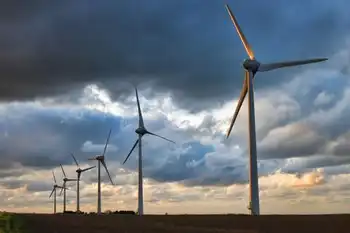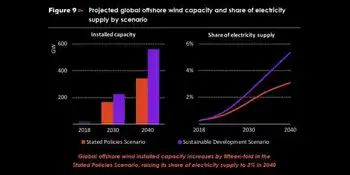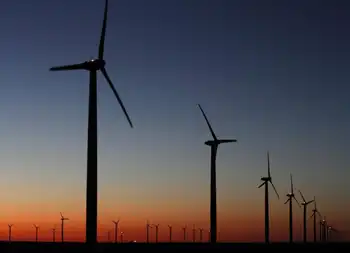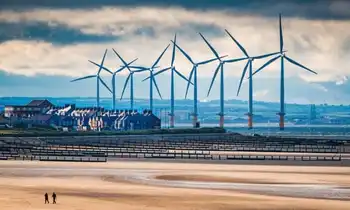The ups and downs of water power
By Toronto Star
High Voltage Maintenance Training Online
Our customized live online or in‑person group training can be delivered to your staff at your location.

- Live Online
- 12 hours Instructor-led
- Group Training Available
Sort of.
In 2004, about 1,400 highly radioactive fuel rods were transferred from pool storage to a secure dry-storage facility. The spent fuel remains there, inside 60 airtight steel canisters spread out over five hectares of fenced-in land.
It's not what most would consider prime real estate – unless, of course, you're John Douglas. The founder and chief executive of Toronto-based Riverbank Power Corp. considers the 160-hectare site an ideal location for his company's first underground power generation project, an initiative that could set the standard for large-scale energy storage.
"Maine will be a great example of what we're trying to do," says Douglas, a former wind developer who sold his business, Ventus Energy Inc., in 2007 for $140 million. Douglas, fully aware that the wind's intermittent nature has limited its potential, has since focused his attention on ways to store that energy – to create, in effect, a massive battery for the grid.
Riverbank plans to dig 600 metres deep and construct massive underground caverns that can hold about 3.8 billion litres of water. Beside the caverns the company will install four turbines, each capable of generating 250 megawatts of electricity. Taken together, that's enough to power 300,000 homes. Each turbine will be connected to a vertical concrete shaft that leads to the surface and opens up to the river.
During times when electricity is in high demand, Riverbank would divert water from the river and let it fall down the long shafts. The motion of the water spins the turbines and generates electricity, which is carried back to the surface and injected into the power grid. The water then flows into the underground caverns for temporary storage.
The system can work for six hours at full tilt until the reservoirs are filled.
At night, when demand is low and power is cheap, and when wind farms are most active, Riverbank would reverse the process by using the hydro turbines to pump the water back to the river, using the off-peak electricity, allowing the process to repeat itself the next day.
Douglas calls his system the Aquabank. He says it will be cheaper to develop than a wind farm with equivalent generating capacity. The business model is simple: Riverbank would earn much of its revenues by selling electricity when the price is highest and buying it when it's lowest.
Aquabank is not much different than a conventional hydroelectric pumped storage station, except that instead of the water falling from a naturally formed reservoir down to a lake or river, the water falls from a lake or river into an underground man-made cavern.
"The excavation of the powerhouse and the underground reservoir is basic underground mining using techniques that have been around for 100 years," says Douglas. "Excavating down 2,000 feet is not a problem if you have the right rock."
Douglas says he started to seriously consider the idea a few years ago while touring the Robert-Bourassa hydroelectric generation station, a part of Hydro-Quebec's James Bay Project and the largest hydro station in Canada. The facility's turbines are located within a giant rock cathedral about 140 metres underground.
For him, it was proof that such massive engineering projects were possible and had enormous advantages over conventional pumped storage. Most natural geological formations that are ideal for above-ground pumped storage are either already developed or too remote, requiring expensive expansions to the transmission network. They also require the flooding of huge swaths of land.
"Building new transmission is no easy feat and when you talk about flooding land, it's really difficult," Douglas says.
Aquabank offers more flexibility in terms of location, as long as some basic conditions are met. Riverbank targets sites that are near large bodies of water and have the right subsurface rock conditions. Sites must also be located near a substation and transmission lines with adequate capacity – requirements that make the Maine Yankee an ideal location.
Stanislav Pejovic, a professor of mechanical engineering at the University of Toronto and an expert in hydraulic energy systems, has been briefed on the Aquabank approach. He says one of the biggest benefits of an underground pumped storage facility is that most of it would be hidden, making NIMBYism less likely.
"You'd only see transmission lines and a small building," Pejovic says. "It's a very positive development. I think in the near future this is important for Ontario."
The province's Independent Electricity System Operator is aware of the Aquabank design and believes the underground pumped-storage concept could prove valuable as Ontario pushes to get more solar and wind power on the grid.
Such intermittent power sources must be shadowed with backup generation, typically natural gas plants, which can be fired up quickly to compensate for power drops that occur when the wind stops blowing or clouds block the sun.
Pumped storage is an ideal replacement for this natural gas generation. It can be turned on and off more quickly. It is free of emissions. And, unlike natural gas, it can absorb surplus power generated overnight when nuclear and wind generation exceeds demand.
It's part of the reason Energy Minister George Smitherman directed the Ontario Power Authority last September to more seriously explore pumped storage as a component of its 20-year system plan.
"I think projects like this are certainly the kind of thing we're encouraging the industry to have a good look at," says Bruce Campbell, vice-president of market development at the system operator. "The thing we particularly find attractive is that it's just very, very flexible."
The bottom line: more system flexibility means more opportunity for renewables.
That's why Maine is interested. Earlier this month Governor John Baldacci mentioned Riverbank during his "state of the state" address and repeated his government's goal of developing 3,000 megawatts of wind generation in the state by 2020.
The $1-billion Riverbank project, he said, would be crucial to reaching that goal.
Ontario shares similarly ambitious goals, which is why Douglas is also eyeing his home province. Having spent $4 million over the past year scouting out the best locations in North America he's identified at least one site in Ontario, out of a list of 15, where the geology, transmission and water availability is ideal and the community supportive enough for a 1,000 megawatt underground station.
"We're looking forward to announcing our location in Ontario."
Riverbank hopes to have five projects permitted by the end of 2010, by which time Douglas is expecting a better environment for projecting financing. The facilities, ideally, would be ready for operation before 2015.
He's got some noteworthy backers. His biggest shareholder is New York-based investment giant BlackRock Inc., which manages $1.3 trillion (US) in assets. Riverbank's chair is former Ontario premier David Peterson and retired Wall Street banker Keith Lord sits on the board.
But Douglas is under no illusion that getting his projects developed will be easy. He knows that in addition to finding the right sites and raising the necessary capital, he'll have to prove the Aquabank design will have minimal impact on the surrounding environment.
"You have to pick a body of water that's big enough so it will have minimal impact on current, flow, temperature and water quality," he says. "Each site we've selected we've completed that analysis. The studies will hopefully prove this out, and nobody is going to let us do this if we're going to wreck a river or lake."











